Korean Hanbok: All You Need To Know About Korea’s National Costume
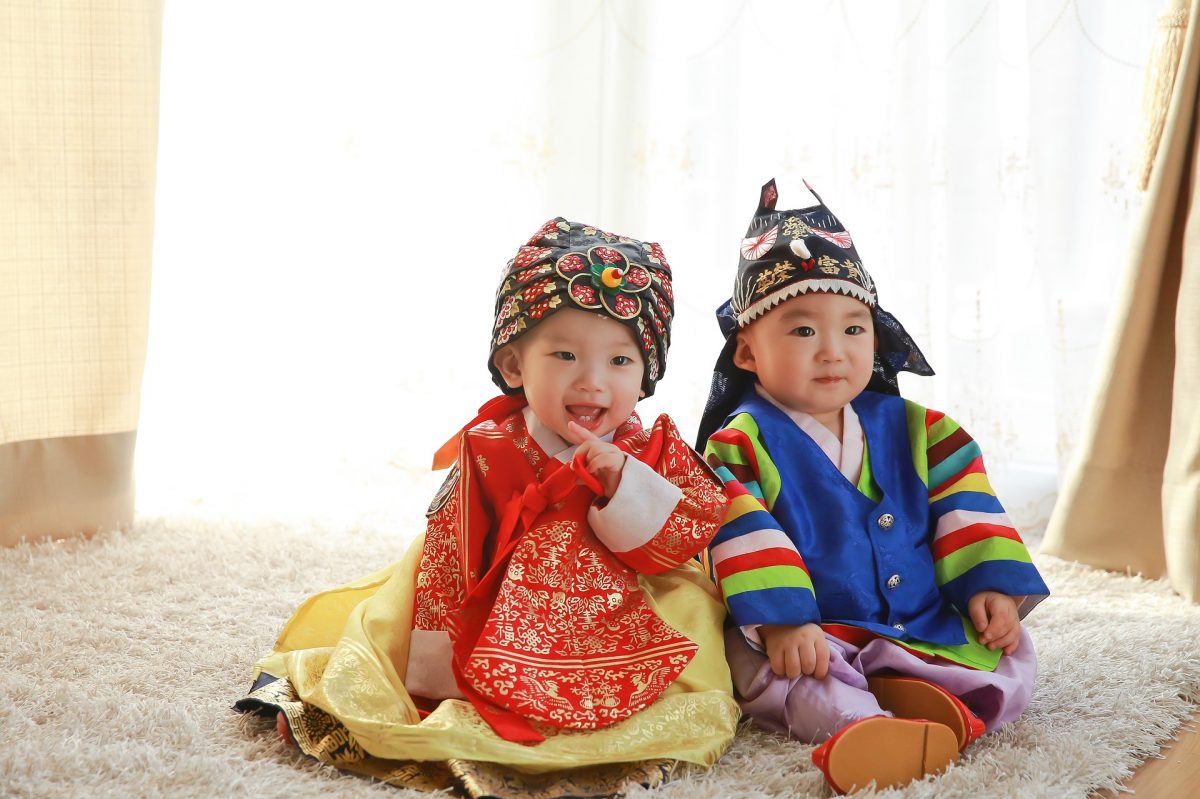
The Korean hanbok isn’t as well-known as other traditional costumes throughout Asia. But it has a long history and a heavy significance for the Korean culture. If you’re taking a trip to Korea, you might get the chance to wear hanbok. And if you’re going to wear it, then you need to do it right because it isn’t as simple as it might appear.
What Is The Hanbok?
There are two main pieces to the hanbok. On the top, both men and women wear a jacket known as a jeogori. On the bottom, women wear a long skirt called a chima. The skirt is quite large, with billowing folds of fabric, and reaches all the way down to the ground. Men wear pants called baji. They’re large and roomy and both the men’s and the women’s version of hanbok is very comfortable.
Hanbok isn’t worn as an everyday garment anymore. These days, most people wear a hanbok only to formal occasions or special events. This includes weddings and New Year’s Day. However, perhaps because of the importance of the hanbok in Korean culture, this historical garment is making a comeback.
The History Of The Hanbok
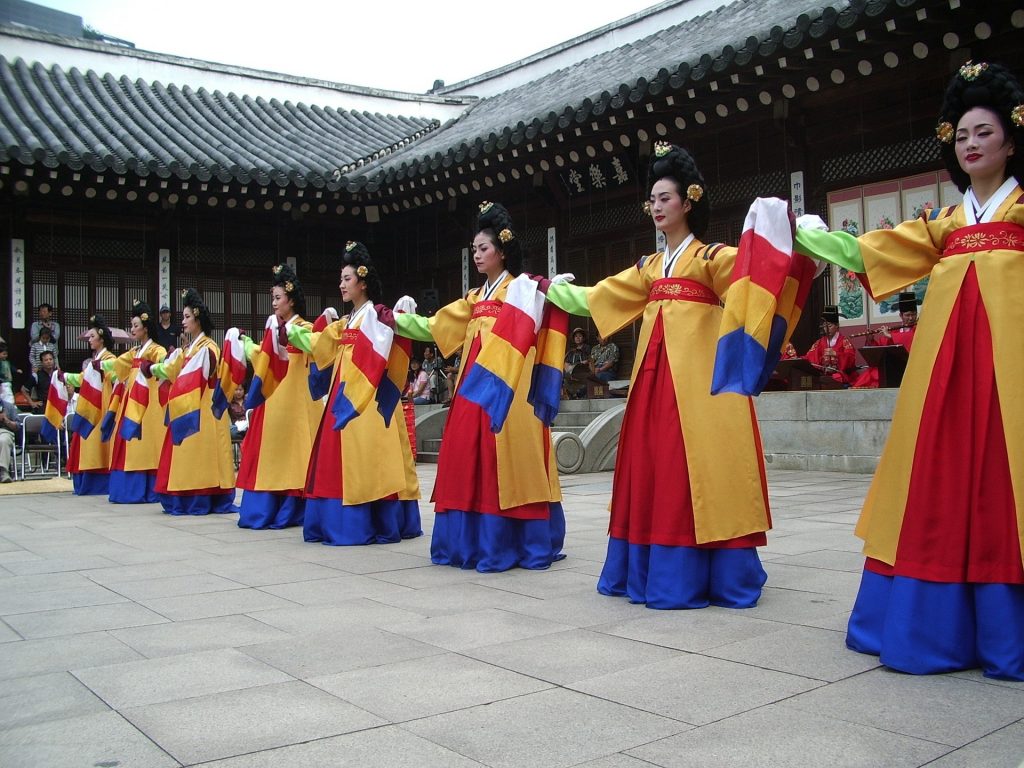
Photo from Pixabay
The hanbok has a very long history in Korea, stretching back to the Goguryeo Dynasty. This dynasty was one of the Three Ancient Kingdoms of Korea and stretched from 37 BCE to 668 CE. However, hanboks today look very different to when they first become fashionable. In these early days of the hanbok, both men and women first wore short baji or trousers and a waist-length jacket.
Over the years, the hanbok was influenced by cultures like the Mongolian empire and internal fashion trends. This resulted in changes to the hanbok. For example, towards the end of the Three Kingdoms era, women started wearing longer skirts and shorter jackets that cinched at the waist. And men followed these trends by wearing looser pants and jackets that bound at the waist.
Hanbok Meanings
The colours and patterns of a hanbok once held significant meanings. Class and marital status were the most important determiners of what people wore. Commoners wore white cotton most of the time, though they were sometimes allowed to wear pink, green, or grey. However, the upper classes had a huge range of choices.
Noblemen and women wore more colours in their hanbok, but there were strict rules governing the use of these colours. Children and young girls could wear bright colours, but older women wore more subdued shades. Unmarried women wore a red skirt and yellow jacket, and married women wore green and red or blue after they had given birth to a son. And the patterns were tightly regulated to flowers or bats.
Members of the royal family got the most choice in hanbok colours and patterns. These held a variety of meanings. Queens wore images of phoenixes, kings wore fire, dragons, mountains, or water plants, and princesses wore butterflies, cranes and lotus flowers. Many of these patterns could only be worn by members of the royal family.
The Modern Hanbok
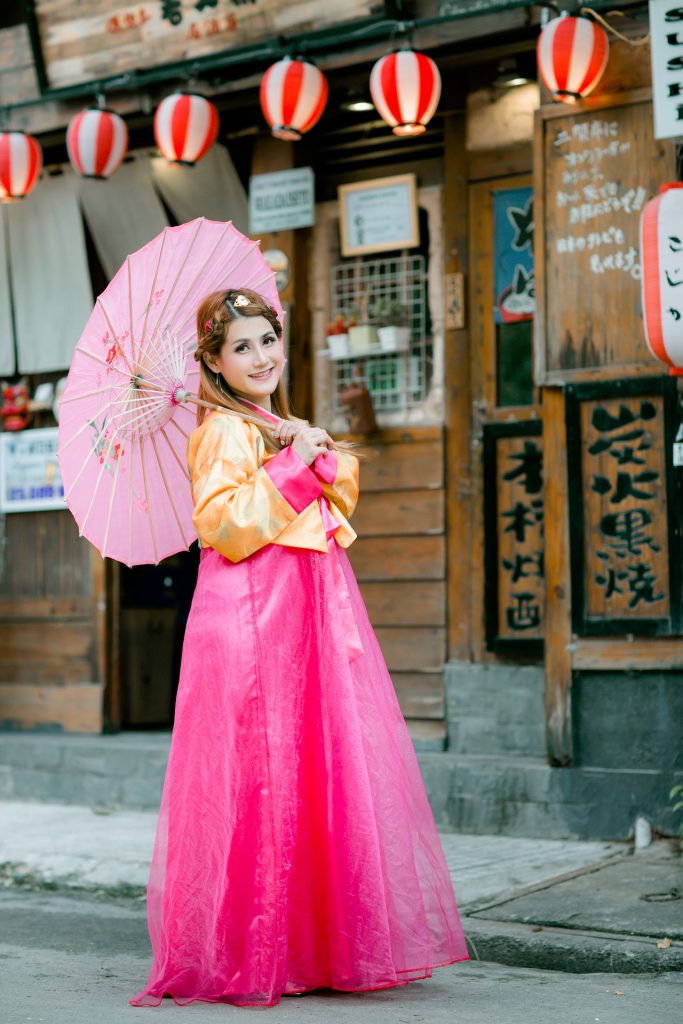
Photo from Pixabay
With all these influences, the modern hanbok is both different and similar to these earlier fashions. They’re still baggy and comfortable to wear. Men wear baggy pants that are cinched at the ankle and tunic-like jackets. Women wear the floor-length, voluminous skirt and a short jacket that ties at the waist.
But what has really changed is the colours and patterns available. The hanbok has been getting a facelift to fit with modern life. These days, bright colours and quirky details and patterns are all the rage as the hanbok goes to the streets of Korea. New fabrics such as denim and gingham are making the style more contemporary and more relevant to modern fashionistas.
And it’s working. Young couples now show off their hanboks on tours and on the streets. It’s quite literally a rebirth and one that should be nurtured.
Today, there are several different types of hanbok available today for different occasions. These include:
The Dol hanbok, worn on a child’s first birthday.
The Hollyebok or wedding hanbok, which is more ornamental than other types.
Hoegabyeon hanbok, to be worn on someone’s 61st birthday to wish them a long life.
Myeongjeol hanbok, which is worn for the Lunar New Year.
How To Wear A Hanbok
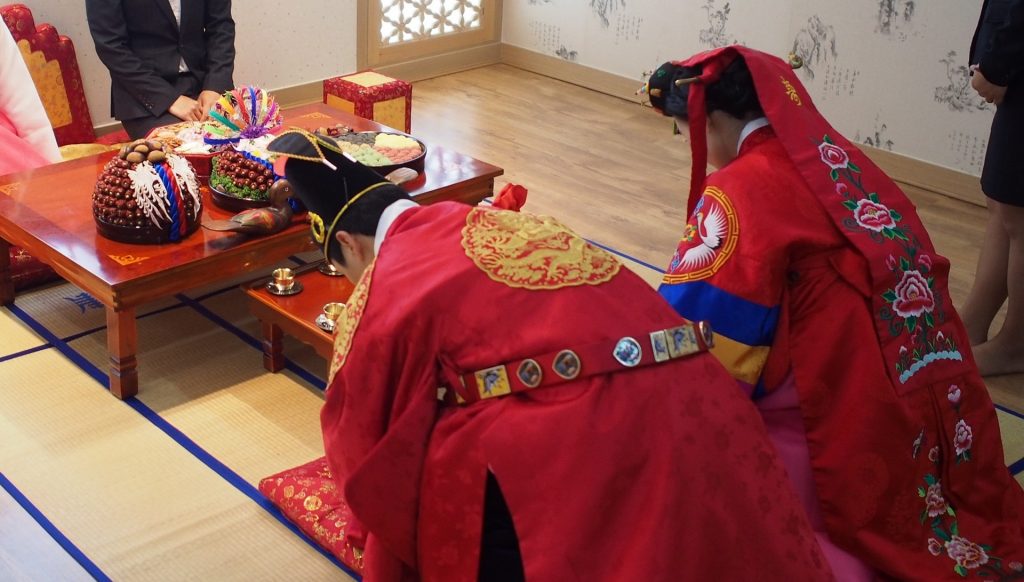
Photo from Pixabay
If you travel to Korea, you might get the chance to wear these traditional clothings. It’s quite common for people to wear them on tours of historical palaces. In fact, many iconic landmarks in Korea offer free entry to anyone wearing a hanbok. So, look out for these deals when you’re travelling in South Korea.
Women’s Hanboks
The modern hanbok is fairly easy to wear, but not easy to put on. Here’s what you’ll need to do:
1. Put on the undergarment dress, which usually fastens in the front.
2. If it’s cold, you can wear jeans or trousers underneath.
3. Wrap the skirt around you with the fabric out and the white surface inside.
4. Cross the ribbon behind you and tie it in a bow at the front.
5. Position the skirt at the bust level.
6. Put the jacket around your shoulders and do up the clasp or button.
7. Put the short ribbon on the long one, making an ‘X’ and tie a knot.
8. Make a loop with the long ribbon and pass the short over, under, and grab it on the other side.
9. Pull the short ribbon to tighten the knot, which should make both ribbons the same length and complete the outfit.
You can wear a vest over the top of the hanbok if it’s cold, or just go out and start exploring the city.
Men’s Hanboks
Putting on a hanbok if you’re a man can be a little complicated too. Here’s how:
1. Put a white t-shirt underneath.
2. Gather the leftover fabric on the right side and cross it to the left.
3. Hold the fabric down and cross the belt over it.
4. Knot the belt in the centre and fold the waistband down to cover the belt.
5. Pull-on the white socks that are worn with the hanbok, ensuring that the seams are straight.
6. Position the pants’ seam on the ankle bone and pull the excess fabric outwards before wrapping it around your ankle.
7. Wrap the ankle strap twice around the fabric to secure it and tie it on the inside of your leg.
8. Repeat with the other foot.
9. Put the jacket on.
10. Tie the inner fastening ribbon on the left.
11. Tie the outer ribbon.
12. Wear the vest over the jacket and do up the buttons.
How To Tie A Hanbok?
Tying the Korean hanbok is probably the trickiest part of wearing traditional attire. Also known as Otkorum, most people get a lot of trouble in this part and often turn the experience into chaos. Remember the first time you did a necktie? Just like that, you might also get everything tangled. To help you pull-through, here’s a step-by-step guide of tying an Otkorum:
1. The jeogori has two ribbons, a short one on the right and a long one on the left. Begin by letting them hang down.
2. Cross the shorter ribbon over the longer one to form an “X”, then make a loop under the left ribbon using the right one to make a simple knot.
3. Using the ribbon that now hangs on the left (formerly the right ribbon), forms a loop by wrapping it around your left palm.
4. Fold the other ribbon by its center then tuck the edge inside the loop you made in your left palm before pulling it on all the way.
5. Take off your hand from the loop and gently tighten it by pulling the folded edge of the long ribbon. The final result should look like a half-done bow tie with the two ribbons hanging on your right chest.
When tying the hanbok, the knot shouldn’t be too tight and the loop should naturally lie on your chest parallel to the ceiling. This type of doing Otkorum applies to both men and women.
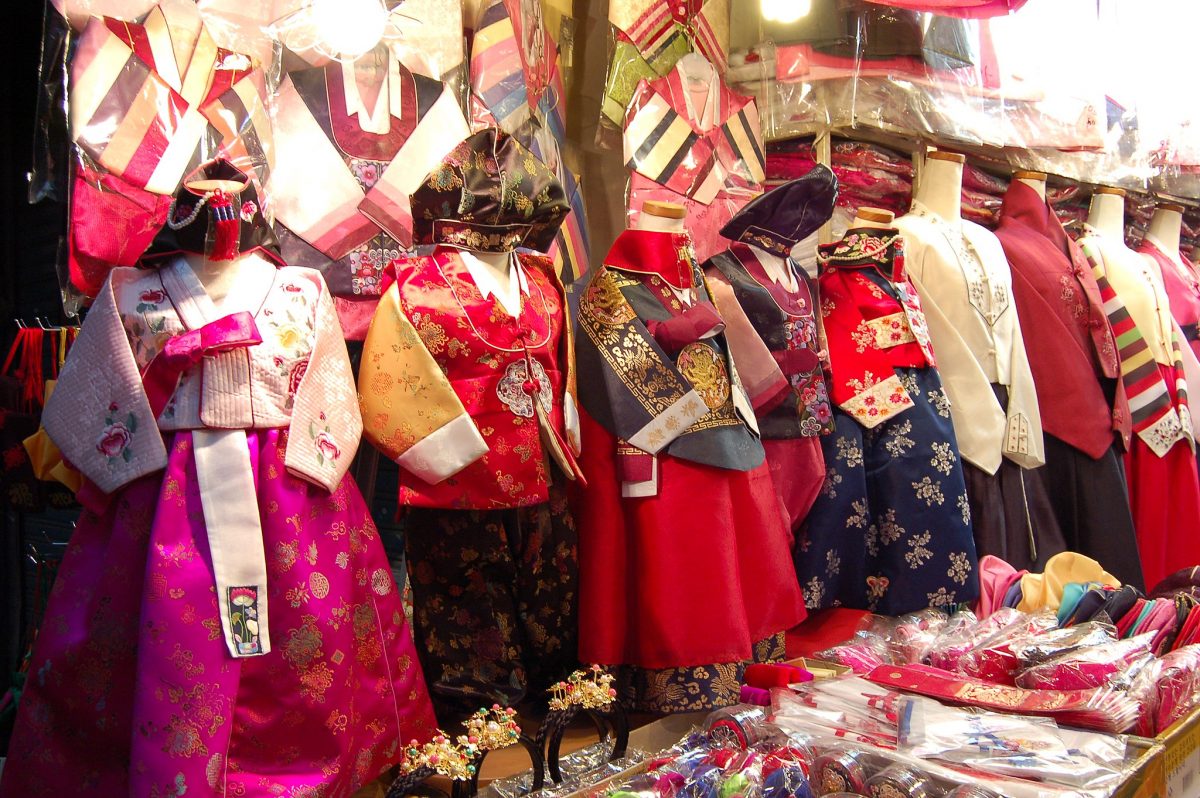
©Photo by frakorea on Wiki commons
Where To Buy Modern Hanbok In Seoul
Right before hanboks completely go out of fashion in Korea, designers reinvent the dress to match today’s fashion trend. From being a traditional attire, some are coming up with a simplified version tailored for daily wear. Some people see this as a downright affront to the tradition, but some argue that it is a way to preserve it.
True enough, hanboks are starting to revive, but this time as part of the Korean street fashion. In Seoul alone, you’ll see a handful of girls wearing the twisted version of Korean hanbok. Matter of fact, you won’t recognize it as hanbok on a first glance until you look closely.
Presently, there are limited stores providing the so-called modern hanboks in Seoul. Should you find one, they tend to be a bit pricey. If you are looking forward to purchasing one, here are some modern hanbok stores you can check out.
Kwangjang/Gwangjang Market
Kwangjang Market is one of the biggest traditional markets in Seoul so it won’t be impossible to find what you are looking for here. All you need is some digging.
There are a handful of stores in Kwangjang that offer ready-made hanboks for different occasions like birthdays and weddings. Ready-to-wear hanboks are a lot cheaper compared to tailor-made hanboks. Depending on the materials, a complete set of hanbok can cost from $172 to $350.
While looking for a perfect fit hanbok, you can also try some of the food stalls in the market that offers traditional Korean cuisine.
Location: 88 Changgyeonggung-ro, Jongno 4(sa)-ga, Jongno-gu, Seoul
Ccomaque
Ccomaque is a modern hanbok store along the Insadong cultural street in Seoul. It caters to both men and women and offers hanbok-inspired garments that you can proudly wear any time of the day. It has Sunday dresses for women as well as skirts and tops. For men, Ccomaque got jeogori-inspired overcoats and baji that resembles jogger pants. They go out of stock easily so you might want to follow them closely for new arrivals.
Location: 35 Insadong-gil, Gwanhun-dong, Jongno-gu, Seoul
Soosulhwa
Located in the Hapjeong-dong neighborhood, Soosulhwa is a popular modern hanbok store among young girls in Seoul. The store offers knee-length to longer modernized hanbok skirts with colorful embroidery. It also has a wide range collection of see-through hanbok inspired tops, as well as printed ones. Soosulhwa’s items are surprisingly cheaper given that most of them are made out of silk and other high-quality materials. Their pricing ranges from $45 to $150.
Location: 31-30 World cup-ro 3-gil, Hapjeong-dong, Mapo-gu, Seoul
DailyHAN
DailyHAN is reinventing the Korean tradition with its collection of casual hanboks and Korean accessories for women. Out of other modern hanbok stores in Seoul, DailyHAN has the closest collection of what a traditional hanbok looks like. With the touch of Sunday dresses, the store offers jeogori matched with knee-length skirts that feature prominent prints and embroideries. It also offers hanbok-inspired tops that you can pair with regular denim pants.
Location: 05624, Seongjeong Building, 474, Songpa-daero, Songpa-gu, Seoul
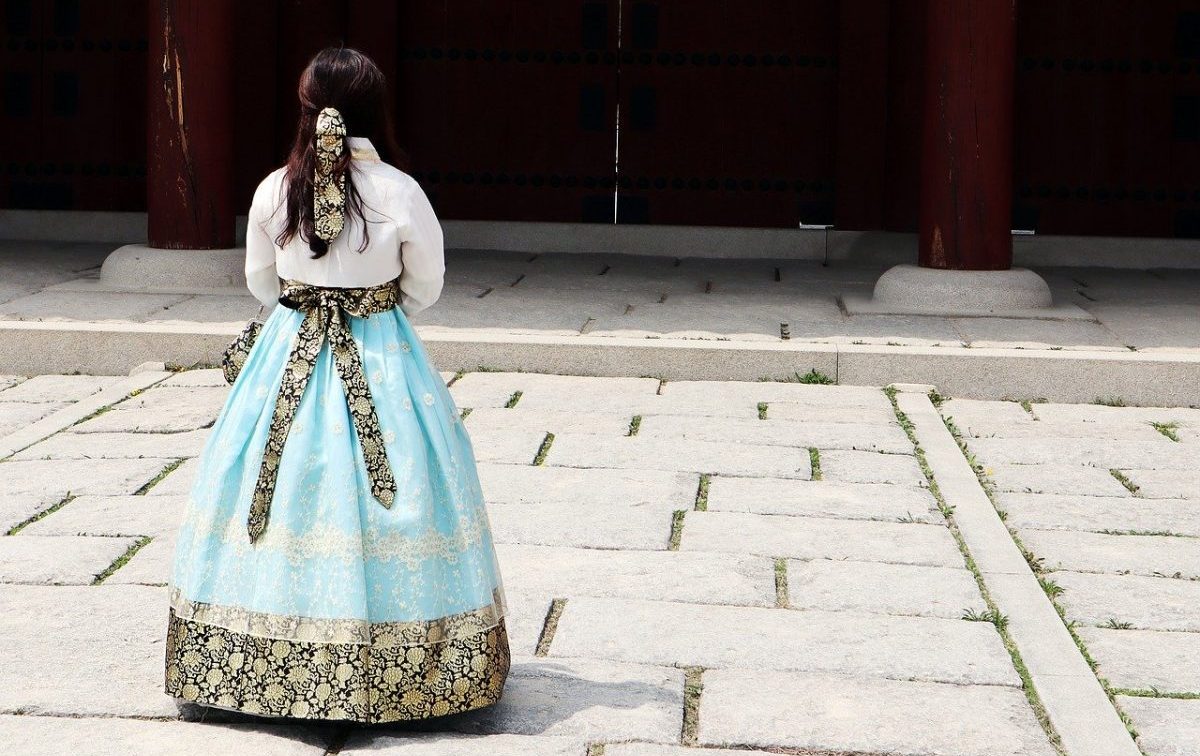
©Photo by Pixabay
Where To Rent Hanbok In Seoul?
Purchasing a hanbok is expensive and it’s not ideal to spend on something you would often use. If you are a tourist and want to experience wearing the traditional attire of Koreans, renting is a better option. Aside from it will save you from unnecessary expenses, renting will save you from the burden of extra baggage.
There are a pretty good number of boutiques where you can rent these traditional attires in Seoul or when you’re in Korea in general. You can find many of them near tourist attractions as they mostly target foreign visitors. Here are some places in Seoul where you can hire a set of Korean hanbok.
Seohwa Hanbok Rental
Renting a hanbok in Seohwa will not just allow you to wear Korean traditional attire, it will also allow you to experience royal life. While on a hanbok, you will have the chance to explore the Gyeongbokgung Palace – an important royal domain that dates back to the Joseon Dynasty.
Seohwa Hanbok Rental has a wide selection of Hanbok designs and sizes. They also provide complimentary accessories like hair bands, ribbons, and handbags for the full look. You can book for a Seohwa Hanbok Rental on different booking sites like KKDay and Klook.
Location: 133-5 Sajik-ro, Sajik-dong, Jongno-gu, Seoul
Bukchon Oneday Hanbok
Another hanbok rental hotspot where you can find a perfect fit traditional Korean attire is the Oneday Hanbok rental in Seoul. This rental shop assists customers, from getting into the attire to completing their getaway look through accessories.
From the rental shop, you can head off straight to the must-see places in the city. You can visit the nearby Bukchon Hanok Village, as well as the Gyeongbokgung and Changdeokgung palace.
Location: 2nd Floor, 4 Bukchonro5-gil, Jongno-gu, Seoul
Hanboknam
Hanboknam is another rental shop in Seoul that can give you a wide range of options. The shop has different types of hanboks for different occasions like weddings, birthdays, new year, and festivals. From women’s hanboks to men’s, Hanboknam has a nice collection of Korean traditional attires. It also offers rentals for kids as well.
Hanboknam’s rental fee varies on what type of hanbok you like and how long you’re going to rent it. If you are a tourist, you can rent it for a couple of hours and explore the city while on the attire. Hanboknam has several locations near Gyeongbokgung, Changdeokgung, Jeonju, and Bukchon which famous for Hanok villages.
Location: 133-5 Sajik-ro, Sajik-dong, Jongno-gu, Seoul
YES Hanbok
If you want a day of hanbok experience, you can have it at YES Hanbok. This hanbok rental shop in Seoul has an impressive collection of traditional hanboks that resemble the attire of royals in the Joseon Dynasty. It offers the traditional baggy and loose clothing embroidered with prominent figures like dragons, floral patterns, and clouds.
The shop is conveniently located near Gyeongbok Palace, the main royal palace of the Joseon dynasty. While wearing a rented hanbok, you can explore the palace and other nearby historical sites for free.
Location: 133-6 Sajik-ro, Jongno-gu, Seoul
Pro-Tip: Although some of the hanbok rental shops in Seoul accept walk-ins, it is essential to book them beforehand. For your convenience, you can go to different online booking sites like Klook and search for the shop where you want to rent a hanbok. Aside from it’s hassle-free, you can also catch discount offers.
Putting on or wearing a hanbok isn’t easy. But it’s worth it because this costume is comfortable to move in and will stand up to a range of temperatures. When you’re exploring Korea, make sure that you take the chance to experience this part of the local culture.

